
Goth is a music-based subculture that began in the United Kingdom during the early 1980s. It was developed by fans of gothic rock, an offshoot of the post-punk music genre. Post-punk artists who presaged the gothic rock genre and helped develop and shape the subculture include Siouxsie and the Banshees, Bauhaus, the Cure, and Joy Division.
Gothic rock is a style of rock music that emerged from post-punk in the United Kingdom in the late 1970s. The first post-punk bands which shifted toward dark music with gothic overtones include Siouxsie and the Banshees, Joy Division, Bauhaus, and the Cure.

Gothic fashion is a clothing style marked by dark, mysterious, antiquated, homogeneous, and often genderless features. It is worn by members of the goth subculture. Typical gothic fashion includes dyed black hair, exotic hairstyles, dark lipstick and dark clothing. Both male and female goths can wear dark eyeliner, dark nail polish and lipstick for a dramatic effect. Male goths use cosmetics at a higher rate than other men. Styles are often borrowed from the punk fashion and can also draw influence from Victorians and Elizabethan fashion. Goth fashion is sometimes confused with heavy metal fashion and emo fashion.
A rivethead or rivet head is a person associated with the industrial dance music scene. In stark contrast to the original industrial culture, whose performers and heterogeneous audience were sometimes referred to as "industrialists", the rivethead scene is a coherent youth culture closely linked to a discernible fashion style. The scene emerged in the late 1980s on the basis of electro-industrial, EBM, and industrial rock music. The associated dress style draws on military fashion and punk aesthetics with hints of fetish wear, mainly inspired by the scene's musical protagonists.
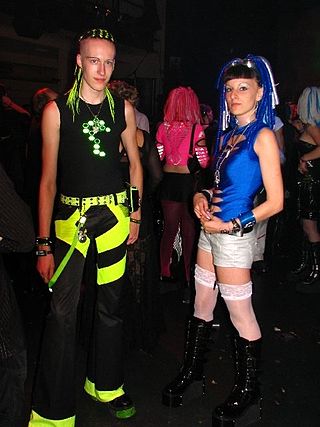
Cybergoth is a subculture that derives from elements of goth, raver, rivethead and cyberpunk fashion.
Dark cabaret is a musical genre that draws on the aesthetics of burlesque, vaudeville and Weimar-era cabaret, with live performances that borrow from the stylings of goth and punk.
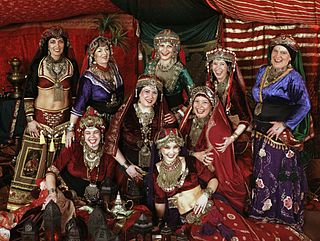
Carolena Nericcio started the Fat Chance Belly Dance troupe, formerly American Tribal. FCBD/ATS developed a unique style of belly dance known simply as the FCBD style, of which the primary defining characteristic is group improvisation. It is generally performed at community events such as festivals and parades, with dancers typically favoring a look provided by wide-legged pants gathered at the ankles, tops known as cholis and full skirts.
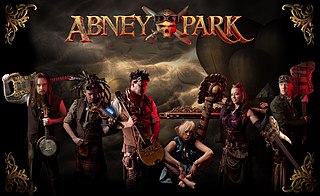
Abney Park is a steampunk band based in Seattle. The band is named after an iconic gothic cemetery, the Abney Park Cemetery in London where Robert Brown, the founder of the band, lived and studied for a period in 1988. Formerly a goth band, Abney Park has transformed their look and sound and has been called the "quintessential spokespeople for the steampunk subculture."
Ethereal wave, also called ethereal darkwave, ethereal goth or simply ethereal, is a subgenre of dark wave music that is variously described as "gothic", "romantic", and "otherworldly". Developed in the early 1980s in the UK as an outgrowth of gothic rock, ethereal wave was mainly represented by 4AD bands such as Cocteau Twins, This Mortal Coil, and early guitar-driven Dead Can Dance.
Bellydance Superstars is a professional American bellydance troupe formed in 2002 by producer and manager Miles Copeland. In its first six years of touring, it presented 700 shows in 22 countries.
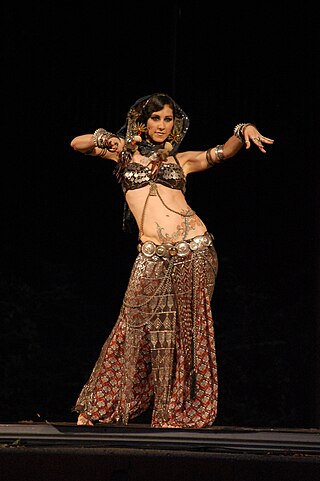
Rachel Brice is an American professional belly dancer in Tribal Fusion style belly dance based in Portland, Oregon. She is the artistic director and choreographer for The Indigo Belly Dance Company and a frequent performer with the Bellydance Superstars. In June 2011 she opened her own dance studio in Portland, Oregon, called Studio Datura. There she hosts regular dance classes along with workshops from her 8 Elements™ Approach to Belly Dance training program.
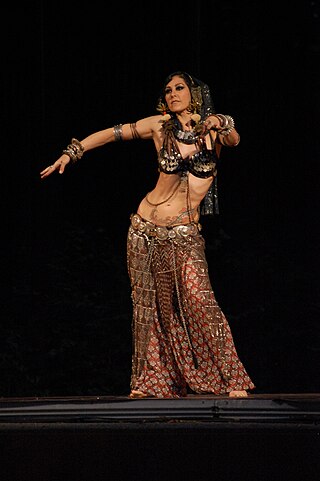
Tribal Fusion Belly Dance is a modern Western form of belly dance that was created by fusing American Tribal Style belly dance and American Cabaret belly dance. Artists frequently incorporate elements from Popping, Hip Hop, 'Egyptian' or 'Cabaret' belly dance, as well as movement principles from traditional forms such as Flamenco, Kathak, Odissi, and other folkloric and classical dance styles.
Belly dance is a Middle Eastern dance that originated in Egypt, which features movements of the hips and torso. An expressive dance, it is one of the oldest forms of dance. It has evolved to take many different forms depending on the country and region, both in costume and dance style; with the Egyptian styles and costumes being the most recognized worldwide due to Egyptian cinema. Belly dancing in its various styles and forms is popular worldwide with many schools around the globe practicing it.
Raks Geek is a bellydance, flow arts, and fire performance company based in Chicago, Illinois. They were the first professional group to successfully combine bellydance and firespinning with geek themes in a consistent manner. They are most known for a viral YouTube video featuring a Wookiee bellydancing to a Klingon band playing original music in Shyriiwook, which was listed on UK Channel 4 TV's "50 Funniest Moments of 2012." They are the most well-known example of fusing bellydance with geek themes and are considered one of the top dance companies in Chicago.
Dawn Xiana Moon is a Chinese American singer-songwriter and bellydancer based in Chicago, Illinois. She is the first musician to blend traditional Chinese music with Americana, pop, and jazz. Moon is also the founder and producer/director of Raks Geek, the first bellydance and fire company of its kind.

Neon is a contemporary belly dance and stiletto dance performer, instructor, and choreographer based in New York City. She is also the founder and owner of Stratostream Entertainment - World Dance New York, a US entertainment company publishing dance instruction, performance, and fitness home video products for women. As a dance instructor Neon has developed innovative visualisation-based methods for teaching dance and dance fitness in an accelerated-learning format.
World Dance New York is a US home entertainment company, releasing and distributing special interest titles on DVD, video on demand, streaming media, iPhone and iPad apps, and a brand of women's dance and fitness home video products. It was founded in 2001 as "Stratostream - World Dance New York". "Stratostream" designates the company in the business-to-business environment, the home video industry, while "World Dance New York" is the publicly-recognized brand and the name of the consumer-facing operation of the company.

Wednesday Mourning is an American actress and model. She specializes in the Goth subculture and has been influential in goth fashion, as well as being the celebrity spokesmodel for Atelier Gothique and appearing as a model for the band My Chemical Romance's CD Welcome To The Black Parade. She was awarded 2010 Goth Day Model of the year and LA Weekly’s Goth Girl of the Week, and since 2012, Mourning has been a co-star on Oddities: San Francisco, a Science Channel program. Mourning is also curator of an esoteric bookstore, Orphic Vellum Books, the only one of its kind in the U.S. She has appeared in several publications including Gothic Beauty and Elle Magazine and is a writing contributor for Celtic Family Magazine.











